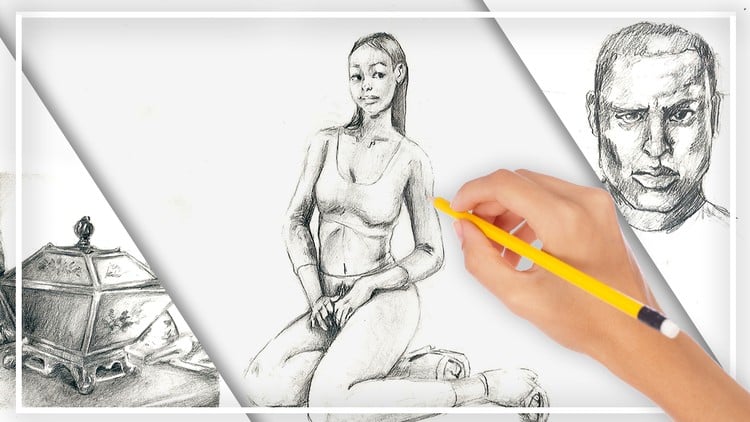
From sketching to human figures and landscapes, anyone can learn how to draw like a pro with this step-by-step course!
Why take this course?
🎨 Complete Drawing Megacourse: Beginner to Expert 🎓
Course Headline: From sketching to human figures and landscapes, anyone can learn how to draw like a pro with this step-by-step course!
Unlock Your Creative Potential!
Have you always wanted to draw but you don’t know where to start? Are you a designer who wants to enhance your illustration skills? Or have you been trying to expand your creative horizons while drawing? Whether you’re a casual artist or aiming to make a career out of it, drawing isn’t just for the pros. Your journey towards mastering the art of drawing begins here!
Why Join This Course?
- Tailored for All Levels: Regardless of your current skill level, this course is designed to take you from beginner to expert in a structured and supportive way.
- Intuitive & Flexible Learning: We blend traditional observational techniques with gestural approaches to help you understand the essence of drawing.
- Observation & Relational Thinking: Learn to observe and think in relationships, which are key to creating compelling drawings.
Course Overview:
In this course, we’ll start with basic observations and progressively delve into more complex concepts. Here’s what you can expect:
- Observational Drawing: We begin by mastering the art of observation, starting with still life setups, objects, images, and shortcuts.
- Sketchbook Adventures: Unleash your ideation skills through dynamic sketchbook activities that will inspire creativity and innovation.
- Expert Guidance: Our seasoned instructors bring years of experience in both drawing and teaching, ensuring a comprehensive learning experience.
- Detailed Syllabus & Examples: The course is meticulously designed with a syllabus that’s easy to follow, complemented by numerous examples and sketches for you to study.
What You Will Learn:
By the end of this course, you will be equipped with the skills to:
- 🎭 Draw complex objects and three-dimensional elements with confidence.
- 🔍 Find and utilize vanishing points, horizon lines, and orthogonal lines in your work.
- ⚫️ Play with contrast levels to add depth and interest to your drawings.
- 🌄 Differentiate between foreground, midground, and background for a more dynamic composition.
- 📐 Master various perspective techniques, including one point, two-point, three-point, and seven-point perspective drawing.
Ready to Embark on Your Drawing Journey?
With this comprehensive course, you’ll gain the skills and confidence to draw and sketch your own ideas like a pro! 🖊️✨
Start drawing today and transform the way you see and interpret the world around you. Enroll in “Complete Drawing Megacourse: Beginner to Expert” now and unlock the artist within! 🌟
- Master Core Drawing Fundamentals: Build an unshakable foundation with essential lines, shapes, forms, and basic sketching techniques, crucial for beginners and experienced artists alike.
- Unravel Light & Shadow: Understand value, contrast, and tone. Skillfully apply chiaroscuro, hatching, and blending to create realistic depth, volume, and dramatic lighting.
- Demystify Perspective: Conquer one, two, and three-point perspective. Construct convincing spaces, architecture, and dynamic environments with accurate spatial relationships.
- Conquer Human Anatomy & Figures: Dive into human proportions, skeletal structure, muscles, and gesture. Draw lifelike and expressive human figures confidently.
- Craft Expressive Portraits: Master facial anatomy, proportions, and expressions. Capture likeness and imbue your portraits with personality and emotion.
- Render Captivating Landscapes: Depict natural elements, atmospheric perspective, and composition. Create depth, scale, and mood in expansive outdoor scenes.
- Explore Diverse Drawing Mediums: Get hands-on with graphite, charcoal, ink, and pastels. Understand their unique properties, applications, and effective combinations.
- Cultivate Observational Skills: Sharpen your artist’s eye to truly see the world, identifying details and translating complex 3D forms onto 2D surfaces accurately.
- Develop Unique Artistic Voice: Move beyond replication. Explore personal expression, interpret subjects creatively, and develop a distinctive style that sets your work apart.
- Master Composition & Storytelling: Arrange elements for balance, rhythm, and visual interest. Guide the viewer’s eye and convey compelling narratives through your compositions.
- Problem-Solve Art Challenges: Equip yourself with strategies to overcome typical hurdles, from proportion errors to creative blocks, ensuring continuous improvement.
- Build Digital Art Foundations: Core principles learned are universally applicable, providing an invaluable base for seamlessly transitioning to digital drawing and painting.
- Create Portfolio-Ready Art: Produce high-quality artwork demonstrating a wide range of skills and subjects, forming an impressive foundation for any portfolio.
- Understand Materials & Workspace: Gain practical advice on choosing materials, setting up an ergonomic workspace, and caring for your tools and finished art.
Why take this course?
- All-Encompassing, Progressive Curriculum: This ‘megacourse’ delivers a meticulously structured, complete learning path from foundational concepts for absolute beginners to advanced techniques for aspiring experts, making it the only drawing course you’ll ever need.
- Actionable, Step-by-Step Demonstrations: Benefit from clear, easy-to-follow, hands-on lessons and practical exercises designed to immediately apply new knowledge, fostering rapid skill development and building confidence in your artistic abilities.
- Flexible, Self-Paced Learning Environment: Enjoy the freedom to progress at your own speed, revisit complex topics as often as needed, and seamlessly integrate learning into your busy schedule, making artistic mastery accessible to everyone.
- Fosters True Artistic Vision and Creativity: Beyond just technical proficiency, the course guides you in developing critical observation skills, advanced problem-solving, and cultivating your unique artistic voice, transforming you into a thinking artist.
- Master Diverse Subjects and Mediums: Gain the versatility to confidently tackle a vast array of drawing subjects – from intricate still lifes and dynamic human figures to expansive landscapes and expressive portraits – across multiple traditional mediums.
CONS:
- Demands Significant Personal Commitment and Practice: While incredibly comprehensive, the depth and breadth of this megacourse necessitate consistent, dedicated practice and self-discipline outside of structured lessons to fully internalize techniques and achieve true mastery.